Hong Kong media tycoon Jimmy Lai jailed after bail revoked











































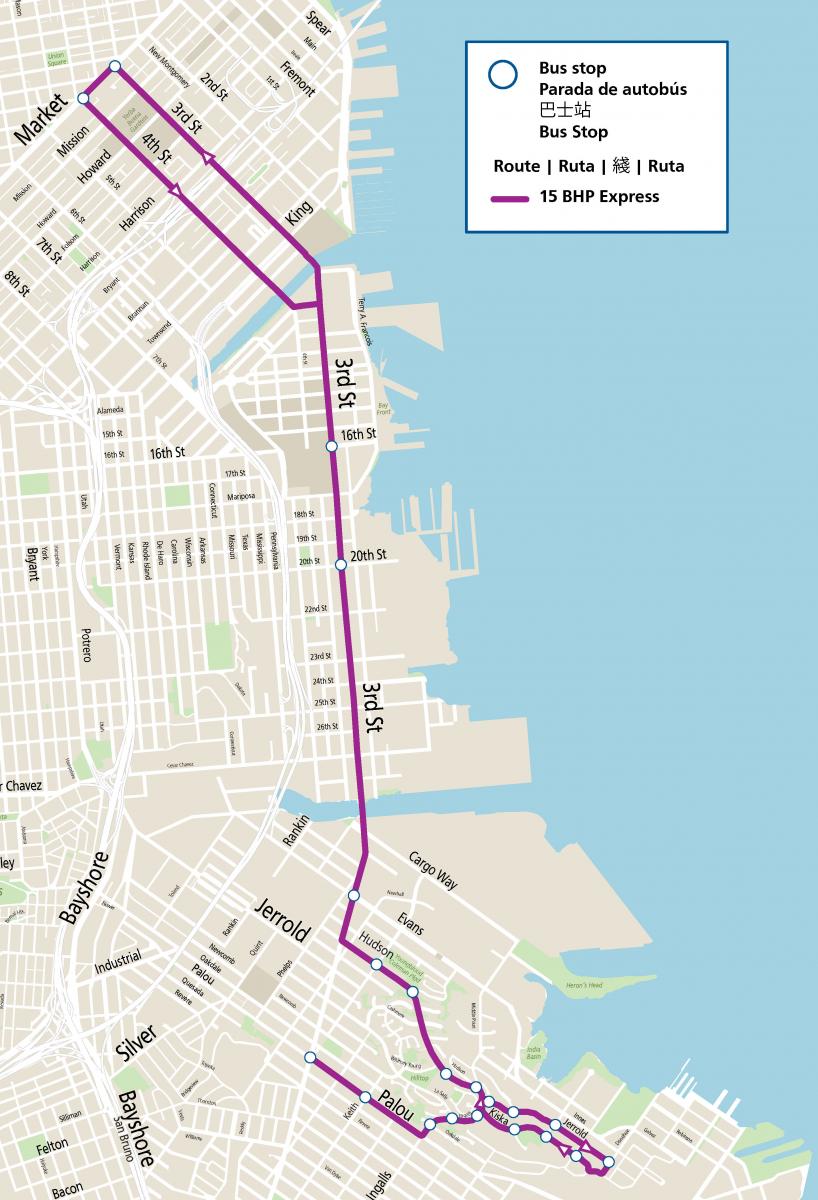
Starting in early 2021, Muni’s new 15 Bayview Hunters Point Express line will improve Downtown access, reduce commute times and add transit capacity for residents of the Bayview and Hunters Point neighborhoods. This community-designed route connects the hilly communities east of Third Street to Downtown and was chosen by residents who voted in a fall 2020 survey. The process and the route demonstrates our commitment to working with communities to provide equitable Muni service.
Launching the new route coincides with the gradual return of Muni Metro rail service. Returning to rail frees up enough buses to run new service, like the 15 Bayview Hunters Point Express and new 27 Bryant route, and improve frequency on other key routes. Service on the 15 will run every 10 minutes from approximately 5:00 a.m. to 10:00 p.m. weekdays and 8:00 a.m. to 10:00 p.m. on weekends.

The Muni Service Equity Strategy highlights the importance of improving transit performance in neighborhoods with high percentages of low-income households and people of color. The Bayview is San Francisco’s most diverse neighborhood, comprised of 27% African Americans, 37% Asian and Pacific Islanders, 24% Latinx, 12% seniors, 24% youth and over 30% of households having less than $30,000 in annual income.
The COVID-19 pandemic has hit Southeast neighborhoods the hardest. Prioritizing transportation for those with the fewest options and in an area with a high concentration of essential workers is a critical principle in our Transportation Recovery Plan. Residents often endure long travel times to get to jobs, health care, education and other essential trips whose destination is not within the neighborhood. Addressing long and unreliable travel times is the most consistent request we receive from customers when identifying needed improvements. The 15 Bayview Hunters Point Express directly responds to this feedback by following the community’s lead in identifying the best way to link the Bayview neighborhood to downtown San Francisco.
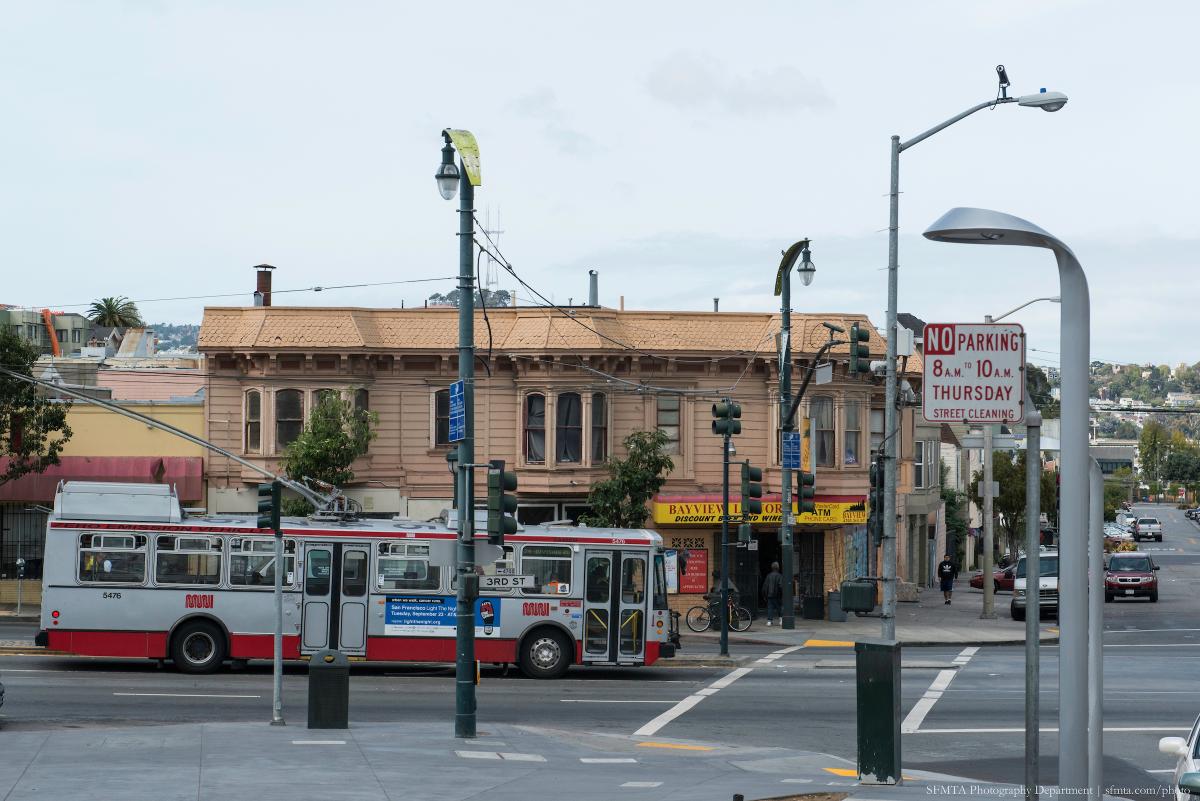
Muni bus on 3rd Street in Bayview
The SFMTA has been working in collaboration with residents of the Bayview and Hunters Point community to improve transportation. Last year the SFMTA adopted the Bayview Community Based Transportation Plan, which identifies transportation priorities that reflect community values and support a growing and resilient Bayview.
In coordination with District 10 Supervisor Shamann Walton’s Office, the SFMTA project team formed a working group comprised of community leaders. In response to COVID-19 physical distancing constraints, the group met virtually and had regular meetings starting in August 2020. The group structure allowed for deep discussions that were critical in identifying key priorities and destinations and provided other important feedback to shape three route alternatives. Those three alternatives were put to a community vote with the preferred option being one that residents felt provided service closer to their homes, made trips shorter and served a part of the community where service is most needed.
We thank Supervisor Shamann Walton’s office, the working group members and all those whose voted on a preferred route – your voice helped us identify and build this exciting new Muni line to serve the community.












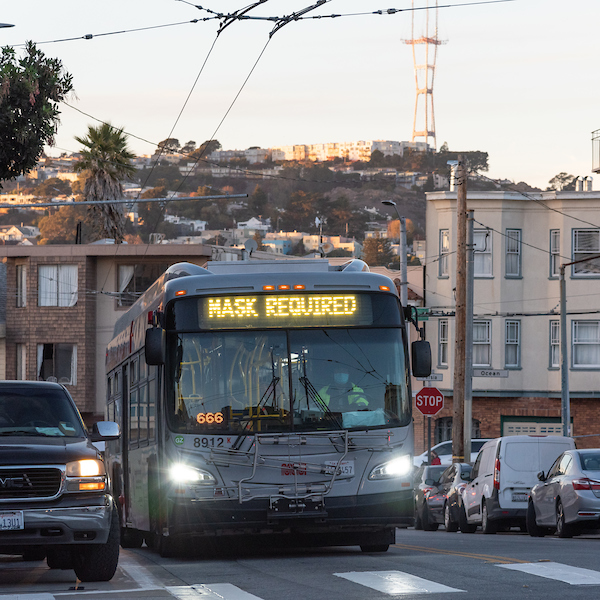
The SFMTA has responded to COVID-19 by working to minimize the risk of transmission and protect the health and safety of our employees and the public. Health and safety is SFMTA’s Transportation Recovery Plan’s number one priority.
To assess how we are doing, the SFMTA has been monitoring data through our Transportation Recovery Plan Dashboards. The Objective 1 dashboard compiles metrics associated with health and safety, including sanitizing vehicles and facilities, promoting physical distancing, and encouraging mask compliance. Here’s what we’re seeing:
As of December 6, operator reported mask-related incidents are down 92% from the peak in April.
Mask compliance on Muni is at an all-time high at 96% of observed passengers wearing masks.
We’ve upped our mask distribution – our Transit Information Program (TIP) staff distributed over 14,000 masks to customers the week of November 16.
To date, no COVID-19 positive cases have been traced to riding Muni.
These findings are even more important as the city and the region have been experiencing a surge in COVID-19 cases after the Thanksgiving holiday. While there is an alarming surge in cases, it's important to recognize that our science-based best practices paired with the public's embrace of critical interventions like wearing a face masks or face coverings allows us to keep our system running for those who need us during this unprecedent time. Additionally, we are maintaining a safe and healthy system so that when increased activity is permitted once again, Muni will be ready for you.
These numbers reflect efforts that have been underway since the beginning of the pandemic to protect operator and customer health and safety. Since March, SFMTA has implemented mitigation measures that limit the possibility of exposure to, and transmission of, COVID-19. To encourage customers to practice good public health behavior throughout their journey, we launched our Ambassador Program in April and expanded it as the TIP program in September. TIP staff provide information to customers on best practices and alternatives to Muni like our recently-launched Essential Trip Card discount taxi program. TIP staff also provide the public with information about COVID-19 Muni Core Service, help manage crowding and distribute masks to customers that may have forgotten theirs.

Other measures Muni has implemented include audio announcements and head signs on buses to remind customers that masks are required when riding Muni. We have also continued the sanitization practices we implemented at the onset of the pandemic. Vehicles return to our operating divisions at the end of each run, so each operator starts their shift with a sanitized vehicle.
The metrics show that these measures and added precautions to ensure the health and safety of our employees and the public are paying off. As the pandemic continues, the SFMTA is committed to using data to inform our COVID response, service delivery, and budget decisions.
Remember, we still need your help. Help reduce the risk of COVID-19 transmission by:
Staying home, except for essential trips.
Shopping locally and supporting your neighborhood businesses.
Wearing a face mask or face covering over your mouth and nose and maintaining physical distance such as leaving a seat open between you and anyone who is not in your household.
Use alternate transportation whenever possible – walk, bike or take a taxi – to save a seat on Muni for those who don’t have other options.
If you do need to travel on Muni:
Please respect your Muni operator. They are working hard for you.
Face coverings are required on Muni. To avoid getting passed up, cover your nose and mouth with face cover or mask while you are waiting for Muni and on Muni.
Board by the back door unless you require assistance.
Give yourself extra time just in case. Your fare is good for two hours across multiple routes.







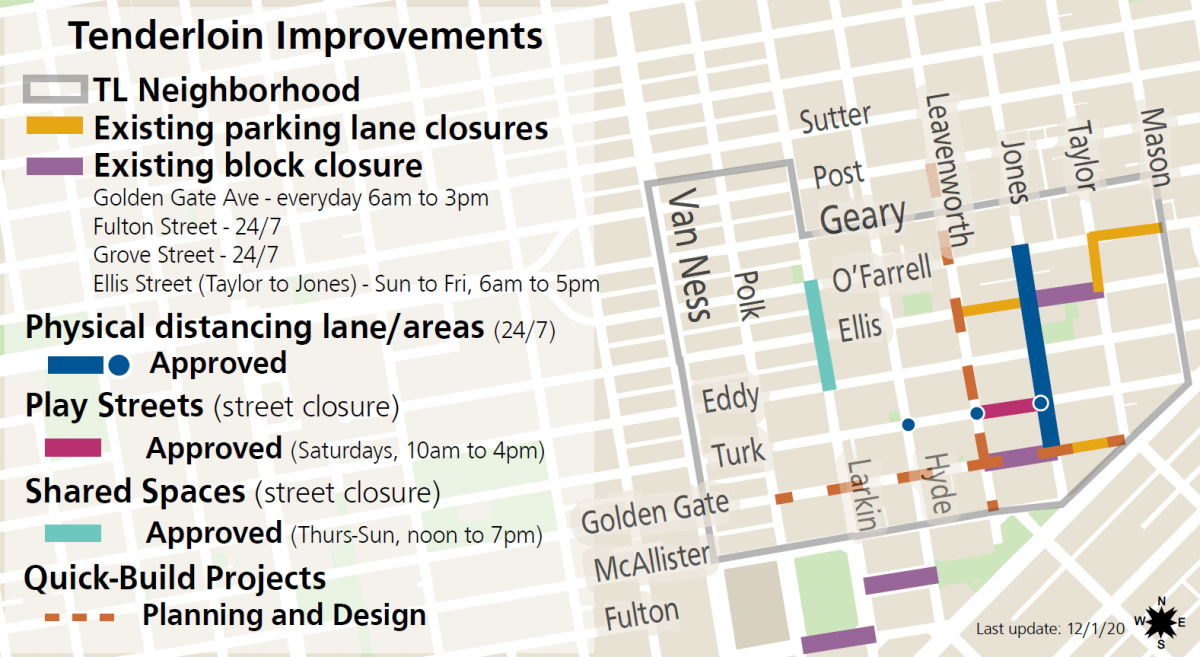
COVID-19 has disproportionately impacted people who live and work in the Tenderloin. As a result, the SFMTA has been working closely with District 6 Supervisor Matt Haney’s office, other city departments, the Tenderloin Traffic Safety Task Force and community members to address the public health issues and unique challenges in the neighborhood through innovative interventions.
The Tenderloin is home to many of our most vulnerable communities including historically marginalized groups such as people with disabilities, residents of SROs and supportive housing and limited-English proficient communities. With every single street in the Tenderloin on the city’s High Injury Network -- the 13 percent of San Francisco streets that account for 75 percent of severe traffic injury collision and fatalities -- this critical neighborhood is the focus of our latest efforts to make the city safer for everyone.
As part of the city’s COVID-19 response, the SFMTA prioritized changes to Tenderloin streets that aim to achieve immediate and long-term results. Our main priorities, based on community advocacy and feedback, are:

SFMTA COVID-19 projects in the Tenderloin:
Upcoming Projects:
Thank You Tenderloin Community!
We want to express sincere appreciation and acknowledge the Tenderloin community groups who have been tenacious in advocating for traffic safety and travel options in their neighborhood: Tenderloin Traffic Safety Task Force, Tenderloin People’s Congress, Tenderloin Community Benefit District, Central City SRO Collaborative, Tenderloin Neighborhood Development Corporation and many others. We are committed to being responsive and partnering with the community as we work through this crisis together.

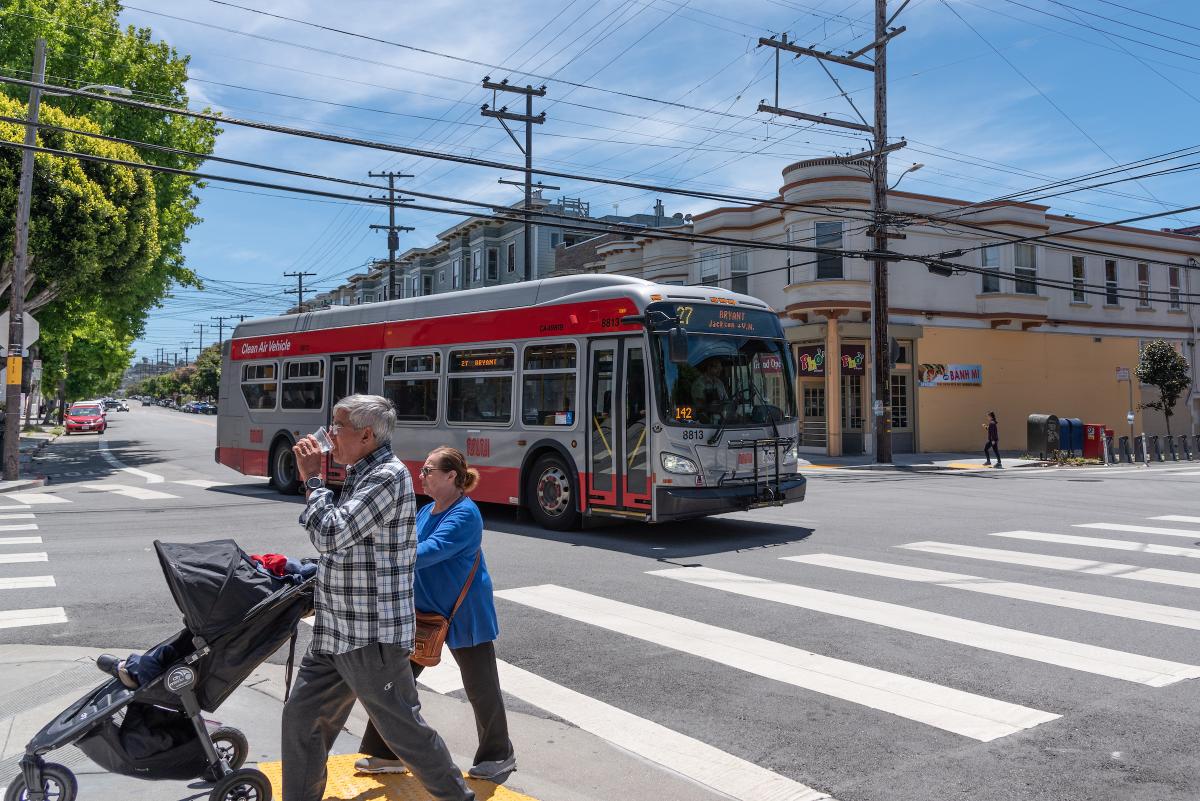
Beginning on Saturday, January 23, the 27 Bryant will return to service with a route realignment that will improve service reliability by using temporary emergency transit lanes.
The 27 Bryant makes critical connections for three of San Francisco’s Muni Service Equity Strategy neighborhoods that have been hit especially hard by the pandemic. The Tenderloin is one of most diverse and dense neighborhoods in San Francisco with many seniors, families, lower income households and persons with disabilities relying on transit. The 27 Bryant will soon travel directly to FoodsCo and Costco in SoMa to provide a connection to other food options. It will also stop just a couple of blocks away from the Mission Food Hub on Alabama Street in the Mission, an organization that provides free groceries to Latinx families.

27 Bryant on Bryant Street at 20th St in the Mission
With the anticipated return of rail in August, SFMTA had initially planned to prioritize the return of the 27 Bryant to service in fall 2020. The unexpected Muni Metro motorization, however, meant that the buses that would have gone to the 27 were put on rail lines instead. The upcoming phased return of rail service in early 2021 allows us to free up buses for the 27 Bryant so customers can again take this line to go grocery shopping, attend medical appointments, and access social services.
Thank you to the community groups, especially in the Tenderloin, for continued advocacy for this essential lifeline throughout the last few months. To engage with community groups representing the neighborhoods served by the 27, staff provided updates at biweeky meetings and hosted a virtual open house in September, inviting key community stakeholders for feedback on proposed changes.
During this emergency period, the 27 Bryant will be on a temporary modified route through SoMa that will travel southbound on Jones connecting to 8th Street between Market and Harrison streets and northbound on 7th Street between Market and Folsom Streets continuing on Leavenworth. The 27 route will not serve Ellis, Eddy, and 5th Streets.
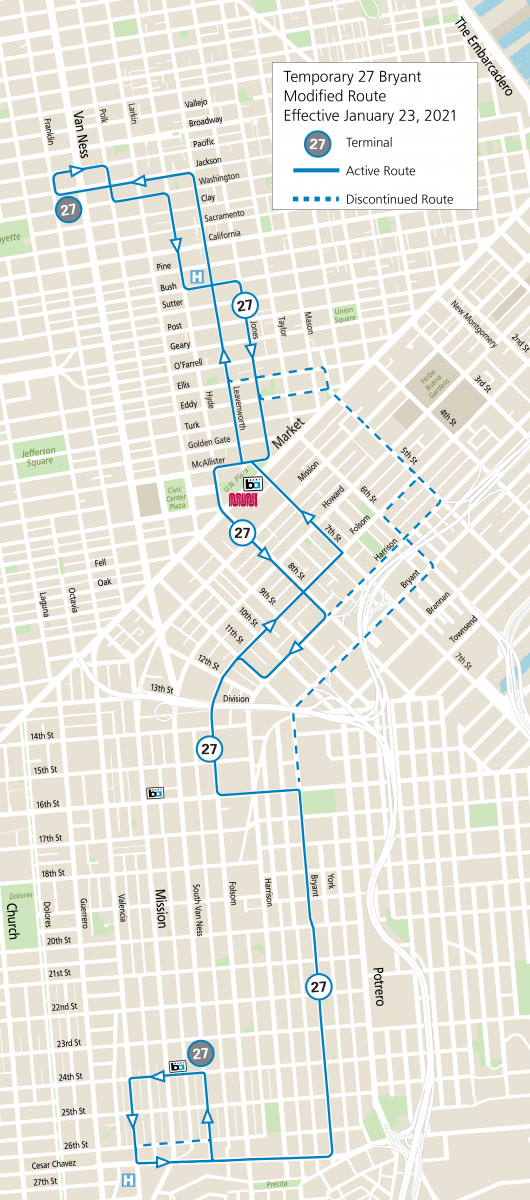
Map of temporary 27 Bryant modified route, the solid blue line indicates active route and dashed blue line indicates discontinued route. Muni and BART icons placed near Powell Station to display option to connect.
The temporary emergency transit lanes that are currently on 7th and 8th Streets restrict private automobiles so Muni service can keep moving. Prior to the pandemic, traffic congestion on 5th Street caused unreliable travel times that can cause long wait times during peak hours. By rerouting the 27 to use the transit lanes, it can help improve the reliability of the route by providing more consistent travel time in that segment and reduce the bunching and gapping that we often see on the 5th Street corridor. This is especially important during the pandemic when avoiding crowded buses is a priority for the SFMTA and riders alike.
Over the next few months, feedback from the Tenderloin, SoMa, and Mission communities will help inform the proposal developed for the permanent route of the 27 Bryant. As for the 31 Balboa, we do not yet have a timeline for the return of this line. Please review the route map for more details including terminal changes and let us know if you’d like to receive updates or have questions or comments by contacting staff:
Jean Long, Transit Planner, Jean.Long@SFMTA.com
Enrique Aguilar, Public Information Officer, Enrique.Aguilar@SFMTA.com